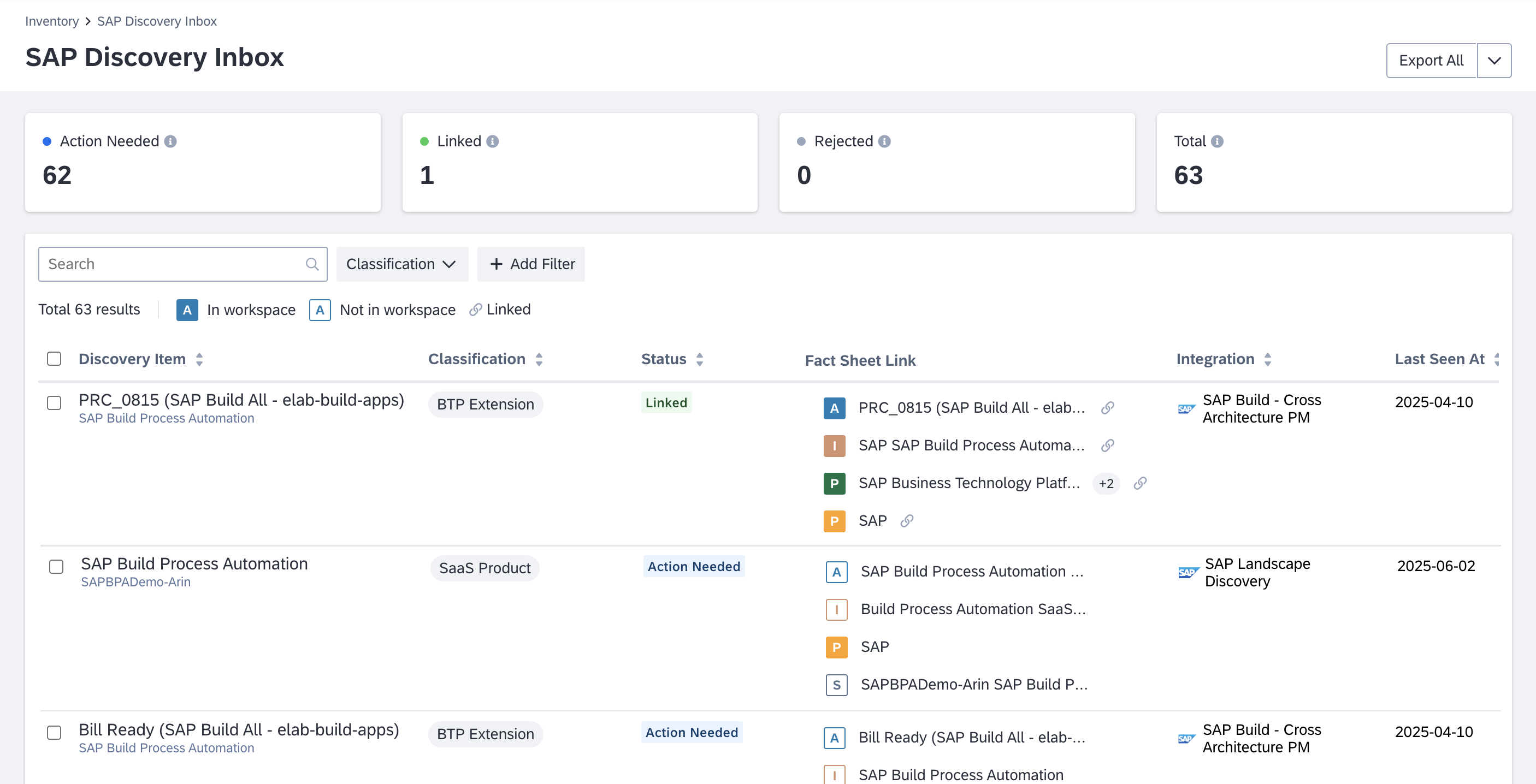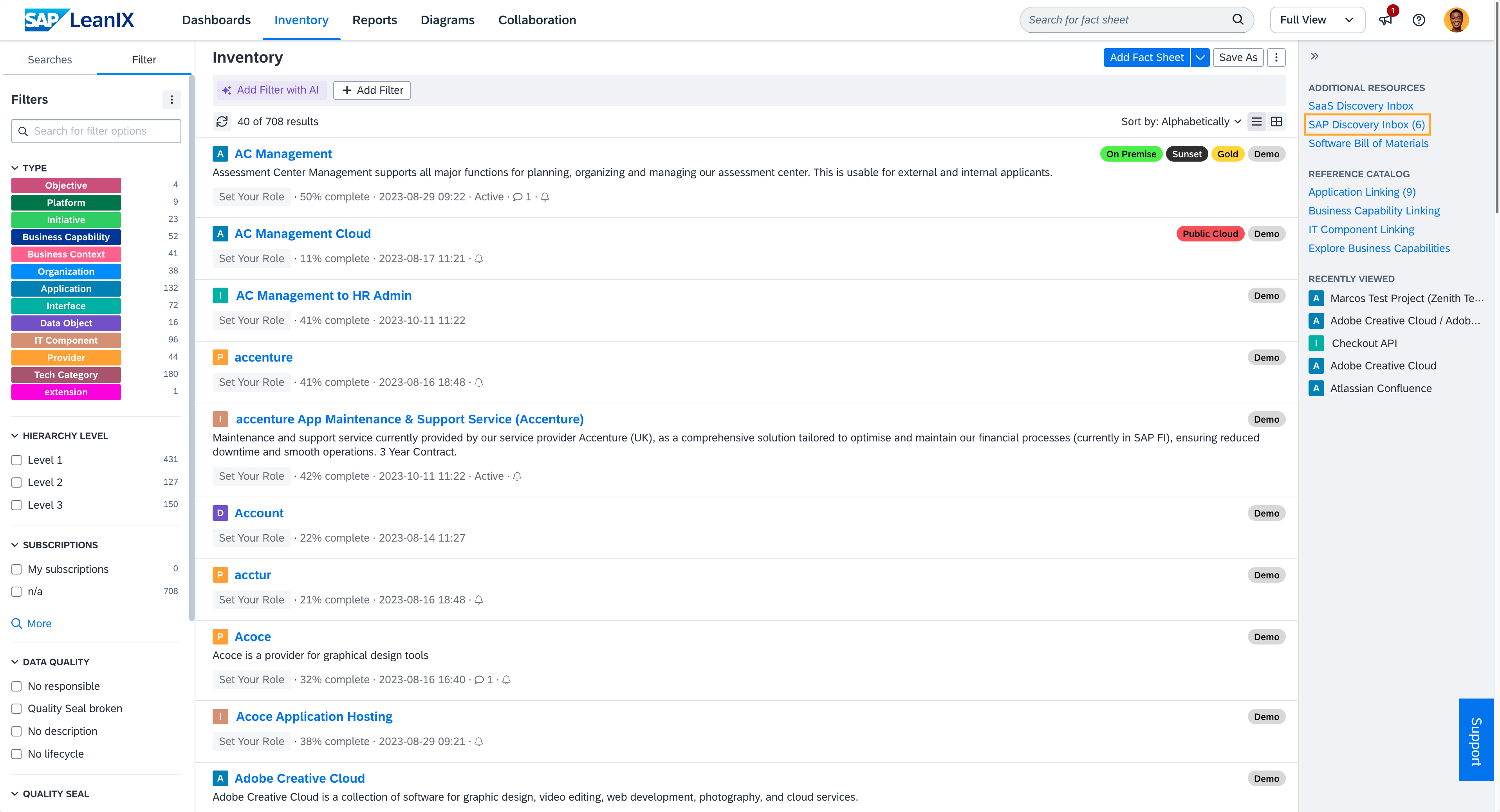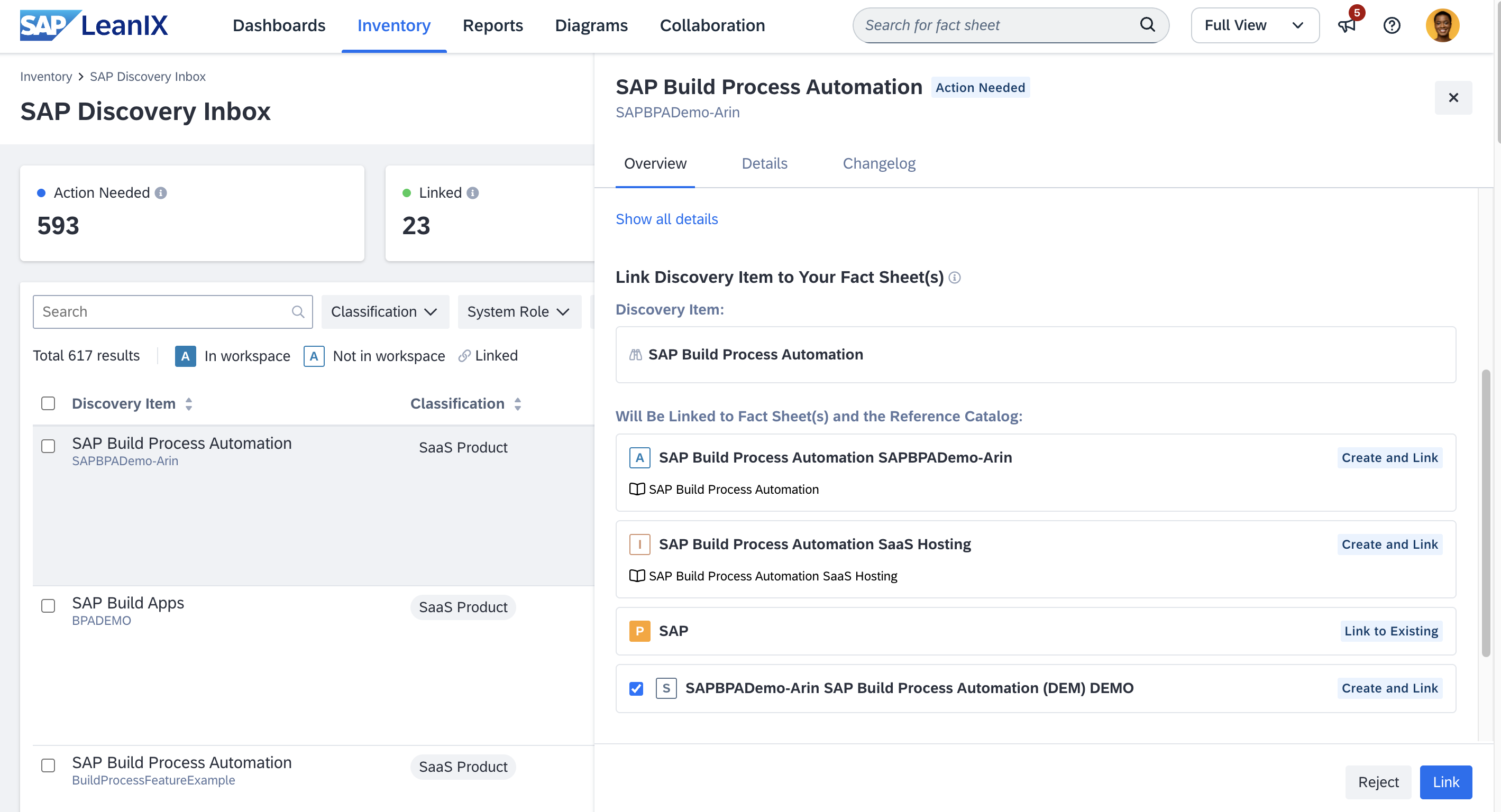SAP Discovery Inbox
Discovered products, services, and extensions from SAP Cloud ALM and SAP Build appear in the SAP discovery inbox. Learn how to create, link, and reject fact sheets related to discovered items.
Overview
Systems, services, and custom-built applications found in your SAP landscape appear in the SAP discovery inbox. You can use the inbox to review these items, link them to existing fact sheets, and create and link new fact sheets. If any of the discovered items aren’t relevant to you, you can always reject them.
SAP LeanIX automatically skips systems, services, and custom-built applications not modeled as applications. It also skips items that aren't relevant for enterprise architecture based on our modeling best practices. These items also don't appear in the inbox. This ensures that your fact sheets follow recommended modeling standards. For more information, visit SAP Modeling Best Practices.
You can also easily reject items that are not needed and focus only on those systems and services that are relevant for enterprise architecture management.

SAP Discovery Inbox
Accessing the SAP Discovery Inbox
You can access the SAP discovery inbox from both the inventory and the administration panel.
Accessing the SAP Discovery Inbox from the Inventory
Note
Only users with admin rights can access the SAP discovery inbox. However, admins can grant access to other roles by configuring permissions in the administration area. For more details, see Role-Based Permissions.
Granting permission to non-admin roles is useful in scenarios where discovered SAP items need to be reviewed by SAP experts and consultants.
To access the inbox from the inventory, do the following:
- Go to the Inventory.
- Select SAP Discovery Inbox in the right panel.

Accessing the SAP Discovery Inbox from the Administration Area
To access the inbox in the administration area, follow these steps:
- Go to Administration > Integrations.
- In the three-dot menu, choose Discovery Inbox.
- Select the SAP Discovery tab.
Filtering and Searching in the Discovery Inbox
Choose Filter to apply different parameters to the discovered SAP list items. Some parameters include:
| Filter Parameter | Description |
|---|---|
| Status | Filter the list by the status of the discovered item, including Linked, Action needed, or Rejected. This helps you identify items that need your attention or review services you’ve already linked or rejected. |
| Classification | Filter by classification, such as SaaS Product (e.g., SAP Ariba Procurement), SaaS ERP (e.g., SAP S/4HANA Cloud), On-Prem System (e.g., SAP Netweaver), or On-Prem ERP (e.g., SAP ERP 6). |
| Product | Filter by product name, such as SAP S/4HANA Cloud. This allows you to review all tenants of a specific product at once. |
| System role | Filter by system role in SAP Cloud ALM, such as PROD, DEVELOP, or TEST. Link only production systems to the inventory. This filter helps you manage tenants that aren’t in production. |
| Action by | Filter the list by the user or system that linked the discovered items to fact sheets. This helps you review services that have already been linked or rejected. |
You can filter by additional criteria, such as location or customer. You can also search for specific entries by name using the search field below the filter button.
Quick Filters
The status cards at the top of the discoveries list act as quick filters. For example, you can click the Action needed card to remove all current filters and apply the filter to only list items requiring action. To remove all filters, click the Total card.
Linking Discovered Items to Fact Sheets
Learn how to link discovered items from your SAP landscape to relevant fact sheets.
Linking Discovered Items to Suggested Fact Sheets
To link discovered items, follow these steps:
- In the discovery inbox, choose the item that needs to be linked.
A side panel opens with more information about the item, along with fact sheet suggestions. - Review the discovery details in the Overview tab.
Use this information to decide whether to link the item to a fact sheet and where to link it. If needed, find more information on the Details tab. - Under Link Discovery Item to Your Fact Sheet(s), select which of the suggested application, IT component, and provider fact sheets you want to link.
If suitable fact sheets are found, the label Link to existing appears next to the item.
If no suitable fact sheets are found, the label Create & Link appears next to the item. - Choose Link.

Reviewing and Linking Discovered Items to Fact Sheets from From the Side Panel
Link Discovered Items to Fact Sheets Other than the Suggested Ones
To link an item to a fact sheet that’s different from the one that the system suggests, do the following:
- Choose a discovered item.
- Under Link Discovery Item to Your Fact Sheet(s) in the side panel, hover over a suggested fact sheet and choose Edit.
- Search for and select the desired fact sheet.
- Choose Link to establish the link.
Linking Multiple Items to Fact Sheets at Once
To link multiple items at once, follow these steps:
- Select the items that you want to link, or select the Discovery Item checkbox to select all.
Use filters to narrow down the list for selection.
For example, you can filter by an integration source and select only those items. - Choose Link.
Note
When you select the checkbox next to Discovery Item, your selection only applies to the items currently visible on the page. To select the complete list, scroll down to load all entries and select the checkbox next to Discovery Item.
Changing Existing Links to Fact Sheets
You can change the link between a discovered item and a fact sheet if a link was added by mistake or if a more suitable option is available.
To change a link, do the following:
- Choose the name of a discovered item to open the side panel.
- Hover over the linked application fact sheet and choose Edit.
- Search for and select the desired fact sheet.
- Choose Link.
Note
To reject a previously linked item without making any changes, click Reject.
Rejecting Discovered Inbox Items
You can reject discovered items to focus on systems and services relevant to your specific enterprise architecture.
To reject discovered items, follow these steps:
- From the list, click on the service that needs to be rejected. This opens the side panel.
- In the side panel, click Reject.
Rejecting Multiple Inbox Items at Once
To reject multiple items at once, follow these steps:
- Select the items that you want to reject, or select the Discovery Item checkbox to select all.
Use filters to narrow down the list for selection.
For example, you can filter by an integration source and select only those items. - Choose Reject.
Comparing SAP Landscape Discovery Against SAP Cloud ALM
The SAP landscape discovery feature uses SAP Cloud ALM as a gateway to connect with your SAP backend repository to access and gather landscape information. You can compare the discovered items against the services in SAP Cloud ALM by navigating to Landscapes in SAP Cloud ALM and filtering for Cloud System under the Deployment Model field.
The SAP landscape discovery feature focuses on SaaS products and SaaS ERP entries, while BTP (PaaS) services, BTP sub-accounts, niche products, and certain product modules are filtered out. As a result, not all services displayed in SAP Cloud ALM will appear in SAP LeanIX's SAP landscape discovery inbox.
If certain services are not visible in SAP Cloud ALM itself, it could be because your organization has not subscribed to them in the BTP Cockpit. If your organization has subscribed but the services are still missing, check the SAP Cloud ALM Troubleshooting Guide. You can also create a support ticket through SAP LeanIX Support or at SAP for Me.
Next Steps
After you process all items, add information about the ownership and business context of the applications. You can then review the technical risks in your landscape and plan your next transformations.
Best Practice
To maintain a clear overview of discovered items, we suggest that you address them promptly. This approach makes it easier to identify and manage newly deployed SAP services. It also helps eliminate blind spots in your enterprise architecture landscape.
Updated 17 days ago
